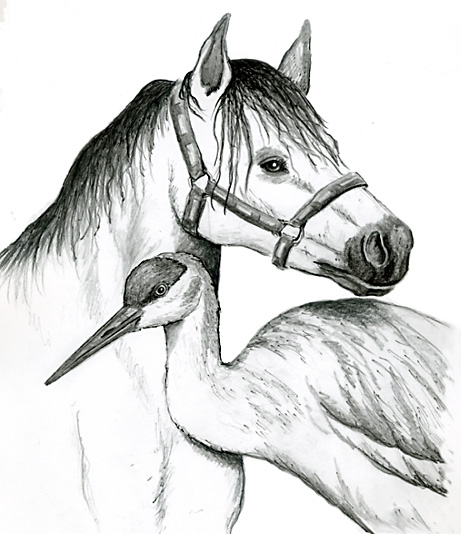
Dear Bird Folks,
Recently I read a book called “Sandy,” about a Sandhill Crane that thought it was a horse. The crane became imprinted on a horse, followed it everywhere and drove the horse berserk by flying into the corral after it. Perhaps you know some other bizarre stories about imprinting?
– Scotty, Orleans, MA
How about a bucket, Scotty?
Is a flock of birds following a bucket tied to a string bizarre enough for you? Back in college I seem to remember watching a film in which some researchers imprinted a bucket on a flock of baby ducks. The little birds followed the bucket around everywhere it went. It’s the same scenario that was played out in the classic epic, “Mary Had a Little Lamb,” only in this case the lamb was a flock of ducklings and the part of Mary was played by a bucket. Rumor has it that the filmmakers originally wanted the ducklings to follow Mary around, but after the massive success of the lamb project, Mary’s asking price became too high. Disappointed, the filmmakers were forced to settle for a little known but less expensive bucket.
Imprinting is a phenomenon that occurs in many young creatures, including birds. Some species of young birds become attached to the first object they see. Of course, the first object they see should be a parent, but that’s not always the case, especially when there are researchers around. Much of the early work on this subject was done by a bearded Austrian naturalist named Konrad Lorens. In the 1930’s Lorens did a study on a newly hatched flock of Greylag Geese. A test was set up so the baby birds would not see any adult geese when they first came out of their shells. Instead of being met by mother goose, they were met by Konrad’s smiling, bearded face. Now you might think that the little geese would be startled, or perhaps even frightened by the sight of the big hairy man, but instead of being scared the tiny goslings were happy to see him and were ready to follow him anywhere.
Now, before we can continue, Scotty, we need to learn a couple of technical words. Many species of ducks, geese and shorebirds are referred to as being “precocial,” meaning that from the day they pop out of the egg they are feathered, able to walk about on their own and can feed and dress themselves. They are quite different than “altricial” birds, which are born naked, immobile and totally dependent on their parents for everything. Songbirds and humans would fit into that category. To review, precocial means feathered, self-sufficient and ready to go; where as altricial means naked, immobile and basically helpless. That’s it. No more tricky words from now on, I promise.
Even though young precocial birds are nearly self-sufficient, they still can’t fly and need a parent’s protection from both predators and weather. Also, often the nest and the feeding areas are in two different locations so the parents must lead the babies to the food. That’s why every spring, on some road somewhere, traffic is stopped as a mother duck leads her family from her secret nesting spot to a feeding pond. In science this is called the “Make Way for Ducklings Syndrome.” I think.
The trouble is, when they crawl out their shells the babies have no idea who their parents are and more importantly, they don’t know what they look like. So, nature has programmed the little birds to run to the first thing they see for safety and protection. Well, I shouldn’t say the first thing they see. Nature doesn’t want the birds running up to a stump, a rock, or a fire hydrant, so the birds are programmed to run to the first object they see that moves. When the mother duck gets up and heads for the water, her babies instinctively know to follow. But what if the first moving thing the young birds see isn’t their mother but some other creature? Will the birds still follow it? There answer is yes, they sure will.
Remember our pal Konrad Lorens and his Greylag Geese from a few paragraphs ago? Well, when the first thing his newly hatched geese saw was old Konrad, they followed him wherever he went. The baby geese weren’t interested in following other adult Greylag Geese or any other bird. To them, Konrad was their source of safety and protection and they weren’t about to let him out of their sight, which explains why Konrad’s house always had newspaper on the furniture.
Over the years experiments have had birds following all sorts of crazy things including dogs, cars, ultralight planes, a bucket tied to a string and in the case of “Sandy,” a horse. I know that story, Scotty, because years ago I bought that book for my baby daughter, whose name is also Sandy. My Sandy is now eighteen years old, but instead of a horse, she apparently was imprinted by her cell phone because in eighteen years she has never let it out of her sight.